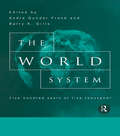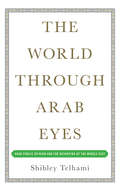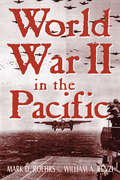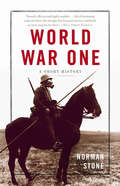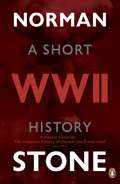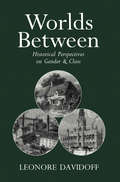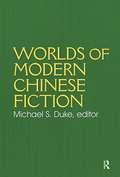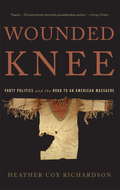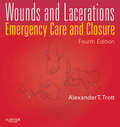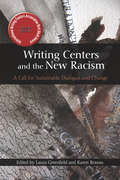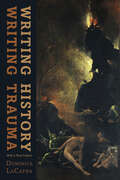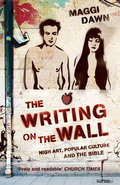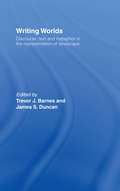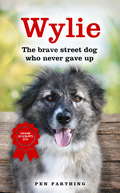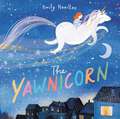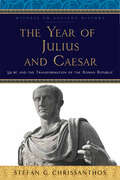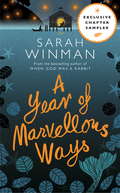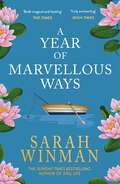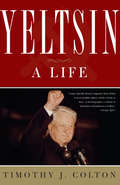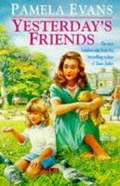- Table View
- List View
The World System: Five Hundred Years or Five Thousand?
by Andre Gunder Frank Barry K. GillsThe historic long term economic interconnections of the world are now universally accepted. The idea of the economic 'world system' advanced by Immanuel Wallerstein has set the period of linkage in the early modern period but Andre Gunder Frank and Barry K. Gills think that this date is much too late. They argue an interconnection going back as much as 5000 years. In The World System, leading academics examine this issue, in a debate contributed to by William H. McNeill and Immanuel Wallerstein among others.
The World Through Arab Eyes: Arab Public Opinion and the Reshaping of the Middle East
by Shibley TelhamiThe uprisings that transformed the Middle East beginning in 2011 have left experts scrambling to understand where the region is likely to go in years to come. But missing from most of the analysis is a longer view of the evolution of Arab Public opinion and identity and how this is likely to influence this fast-changing region. In The World Through Arab Eyes, Shibley Telhami shows how the roots of these rebellions stretch back decades and explains how they will continue to affect the stability of the Middle East in the years to come. Telhami draws on a decade's worth of polling data and analysis to provide a comprehensive look at this evolution of Arab identity and opinion. The demand for dignity, which was foremost in the chants of millions of Arab demonstrators, went far beyond being a struggle for "food” and individual rights. Telhami identifies the key prisms through which Arabs view issues ranging from democracy and religion to foreign actors, including the United States, European and Asian countries, Iran, Turkey, and, centrally, Israel. These prisms provide a key to interpreting the past, comprehending the seismic changes in Arab politics today, and engaging with the region in the future.
World War II in the Pacific: History Of World War Ii In The Pacific
by William A. Renzi Mark D. RoehrsWorld War II laid the groundwork for much of the international system that exists today, especially in the Pacific Rim. This brief but comprehensive survey of the War in the Pacific incorporates both United States and Japanese perspectives, providing a global approach to the Asian theater of the conflict. Drawing on decades of new scholarship and written in an engaging, narrative style, this book traces United States-Japanese relations from the late nineteenth century to the war's end in 1945. It covers every aspect of the war, and gives special attention to ongoing historical debates over key issues. The book also provides new details of many facets of the conflict, including expansionism during the 1930s, events and policies leading up to the war, the importance of air power and ground warfare, military planning and strategic goals, the internment of Japanese-Americans in the U.S., Allied plans and disputes over Russian participation, the decision to drop the atomic bomb, and conditions for surrender.
World War One: A Short History
by Norman StoneThe First World War was the overwhelming disaster from which everything else in the twentieth century stemmed. Fourteen million combatants died, four empires were destroyed, and even the victors' empires were fatally damaged. World War I took humanity from the nineteenth century forcibly into the twentieth-and then, at Versailles, cast Europe on the path to World War II as well. In World War One, Norman Stone, one of the world's greatest historians, has achieved the almost impossible task of writing a terse and witty short history of the war. A captivating, brisk narrative, World War One is Stone's masterful effort to make sense of one of the twentieth century's pivotal conflicts.
World War Two: A Short History
by Norman StoneA pacy, compelling and penetrating account from Wolfson Prize-winning author Norman Stone, that shows World War Two in a fresh new lightThe Second World War is the nightmare that sits at the heart of the modern era - a total refutation of any notion of human progress and a conflict which still haunts us seventy years on.Norman Stone's gripping new book aims to tell the narrative of the war in as brief a compass as possible, making a sometimes familiar story utterly fresh and arresting. As with his highly acclaimed World War One: A Short History, there is a compelling sense of a terrible story unfolding, of a sceptical and humorous intelligence at work, and a wish to convey to an audience who may well have no memory of the conflict just how high the stakes were.This is a beautifully written, clever and imaginative attempt to convey what can almost not be conveyed. About the author:Norman Stone is one of Britain's greatest historians. His major works include The Eastern Front, 1914-1917 (winner of the Wolfson Prize and published by Penguin), Europe Transformed and The Atlantic and Its Enemies (published by Penguin). He has taught at the universities of Cambridge, Oxford and Bilkent, where he is now Director of the Turkish-Russian Centre. He lives in Ankara.Reviews:'Professor Norman Stone has achieved the impossible; he has somehow written a comprehensive history of the Second World War in just under 200 pages, summarising the entire conflict while leaving out nothing of importance and bringing his lifetime of study of the subject to bear in a witty, incisive and immensely readable way ... Norman Stone has proved yet again that he is one of the most original, witty and powerful British historians writing today' Andrew Roberts, Standpoint'The joy and strength of this compact history, besides its trenchancy and, in the publishers' words, the "sceptical and humorous intelligence at work", is its narrative clarity ... a book to clear the mind after the grand tour of the big volumes' Allan Mallinson, The Times'Novices will receive a painless introduction, but educated readers should not pass up the highly opinionated prologue and epilogue and the author's trademark acerbic commentary throughout ... Readers of all stripes ... will find plenty to ponder' Kirkus Reviews
Worlds Between: Historical Perspectives on Gender and Class
by Leonore DavidoffThis book presents a series of pioneering studies which together constitute a reappraisal of our understanding of the relationship between gender and history.
Worlds of Modern Chinese Fiction: Short Stories and Novellas from the People's Republic, Taiwan and Hong Kong
by Michael S. DukeThis book's pluralistic, non-dogmatic, and committed investigation of the values of ecological sustainability, economic justice, and human dignity provides balanced analysis of environmental problems and their potential solutions.
Worlds of Modern Chinese Fiction: Short Stories and Novellas from the People's Republic, Taiwan and Hong Kong
by Michael S. DukeThis book's pluralistic, non-dogmatic, and committed investigation of the values of ecological sustainability, economic justice, and human dignity provides balanced analysis of environmental problems and their potential solutions.
Wounded Knee: Party Politics and the Road to an American Massacre (Great Plains Photography Ser.)
by Heather Cox RichardsonOn December 29, 1890, American troops opened fire with howitzers on hundreds of unarmed Lakota Sioux men, women, and children near Wounded Knee Creek in South Dakota, killing nearly 300 Sioux. As acclaimed historian Heather Cox Richardson shows in Wounded Knee, the massacre grew out of a set of political forces all too familiar to us today: fierce partisanship, heated political rhetoric, and an irresponsible, profit-driven media.Richardson tells a dramatically new story about the Wounded Knee massacre, revealing that its origins lay not in the West but in the corridors of political power back East. Politicians in Washington, Democrat and Republican alike, sought to set the stage for mass murder by exploiting an age-old political tool-fear. Assiduously researched and beautifully written, Wounded Knee will be the definitive account of an epochal American tragedy.
Wounded Knee: Party Politics and the Road to an American Massacre (Great Plains Photography Ser.)
by Heather Cox RichardsonOn December 29, 1890, American troops opened fire with howitzers on hundreds of unarmed Lakota Sioux men, women, and children near Wounded Knee Creek in South Dakota, killing nearly 300 Sioux. As acclaimed historian Heather Cox Richardson shows in Wounded Knee, the massacre grew out of a set of political forces all too familiar to us today: fierce partisanship, heated political rhetoric, and an irresponsible, profit-driven media. Richardson tells a dramatically new story about the Wounded Knee massacre, revealing that its origins lay not in the West but in the corridors of political power back East. Politicians in Washington, Democrat and Republican alike, sought to set the stage for mass murder by exploiting an age-old political tool -- fear. Assiduously researched and beautifully written, Wounded Knee will be the definitive account of an epochal American tragedy.
Wounds and Lacerations - E-Book: Emergency Care and Closure
by Alexander T. TrottWith Wounds and Lacerations: Emergency Care and Closure, you'll get clear, concise guidance on the latest techniques and strategies for treating lacerations, wounds, and burns. This medical reference book will help you optimize every aspect of patient care based on current literature and guidelines.Expedite review and reference with a bulleted "Key Practice Points" section at the beginning of each chapter. Quickly reference the latest recommendations for tetanus and rabies prophylaxis. Implement the latest approaches for the use of ultrasound in foreign-body detection and removal; use of absorbable sutures on the face and hand; approaching complicated infections such as MRSA; managing chronic wounds seen in elderly and diabetic patients; applying new suture techniques and materials for pediatric patients; and updated recommendations for tetanus and rabies prophylaxis. Get step-by-step visual guidance on all aspects of wound care through more than 300 detailed line drawings and photographs showing techniques for wound assessment, irrigation, closure, wound dressing, foreign body removal, administration of local anesthesia, and follow-up care. Quickly find all the relevant information necessary to treat patients with material that focuses only on injuries that are handled by emergency physicians.
Writing Centers and the New Racism: A Call for Sustainable Dialogue and Change
by Greenfield, Laura; Rowan, KarenNoting a lack of sustained and productive dialogue about race in university writing center scholarship, the editors of this volume have created a rich resource for writing center tutors, administrators, and scholars. Motivated by a scholarly interest in race and whiteness studies, and by an ethical commitment to anti-racism work, contributors address a series of related questions: How does institutionalized racism in American education shape the culture of literacy and language education in the writing center? How does racism operate in the discourses of writing center scholarship/lore, and how may writing centers be unwittingly complicit in racist practices? How can they meaningfully operationalize anti-racist work? How do they persevere through the difficulty and messiness of negotiating race and racism in their daily practice? The conscientious, nuanced attention to race in this volume is meant to model what it means to be bold in engagement with these hard questions and to spur the kind of sustained, productive, multi-vocal, and challenging dialogue that, with a few significant exceptions, has been absent from the field.
Writing History, Writing Trauma (Parallax: Re-visions of Culture and Society)
by Dominick LaCapraTrauma and its aftermath pose acute problems for historical representation and understanding. In Writing History, Writing Trauma, Dominick LaCapra critically analyzes attempts by theorists and literary critics to come to terms with trauma and with the crucial role post-traumatic testimonies—notably Holocaust testimonies—assume in thought and in writing. These attempts are addressed in a series of six interlocking essays that adapt psychoanalytic concepts to historical analysis, while employing sociocultural and political critique to elucidate trauma and its aftereffects in culture and in people. This updated edition includes a substantive new preface that reconsiders some of the issues raised in the book.
Writing History, Writing Trauma (Parallax: Re-visions of Culture and Society)
by Dominick LaCapraTrauma and its aftermath pose acute problems for historical representation and understanding. In Writing History, Writing Trauma, Dominick LaCapra critically analyzes attempts by theorists and literary critics to come to terms with trauma and with the crucial role post-traumatic testimonies�notably Holocaust testimonies�assume in thought and in writing. These attempts are addressed in a series of six interlocking essays that adapt psychoanalytic concepts to historical analysis, while employing sociocultural and political critique to elucidate trauma and its aftereffects in culture and in people. This updated edition includes a substantive new preface that reconsiders some of the issues raised in the book.
Writing In Action (PDF)
by Paul MillsWriting in Action provides a step-by-step, practical guide to the process of writing. Although the emphasis is on creative writing, fiction, poetry and drama, it also covers autobiographical writing, the writing of reports and essays. Because this is a book about process, rather than product, Writing in Action also looks at the practice of adaptation and editing. Writing in Action: shows new writers how to get started develops the confidence of more experienced writers encourages experimentation and creativity stimulates critical awareness through inclusion of illustrative texts encourages writing as a skill, as well as an art-form Writing in Action enables new writers to get close to the experience of writing; the questions writers ask, and the choices they make. The book is crammed with practical suggestions and self-evaluation exercises, as well as invaluable tips on style, sentence structure, punctuation and vocabulary. This is an ideal course text for students and an invaluable guide to self-study.
The Writing on the Wall: High Art, Popular Culture and the Bible
by Maggi DawnIn an increasingly secularised society, the average person is unlikely to have a working knowledge of the Bible. Yet a great deal of our culture is built on stories or ideas that come from the Bible. Literature, art, music, language and even the fabric of our society - such as our justice system - is built on Christian concepts and biblical references. THE WRITING ON THE WALL provides a fascinating introduction to the Bible's best-known, and most influential, stories.
Writing Worlds: Discourse, Text and Metaphor in the Representation of Landscape
by Trevor J. Barnes James S. DuncanWriting Worlds represents the first systematic attempt to apply poststructuralist ideas to landscape representation. Landscape - city, countryside and wilderness - is explored through the discourse of economics, geopolitics and urban planning, travellers descriptions, propaganda maps, cartography and geometry, poetry and painting. The book aims to deconstruct geographical representation in order to explore the dynamics of power in the way we see the world.
Wylie: The Brave Street Dog Who Never Gave Up
by Pen Farthing'When people gave up on Wylie, Wylie refused to give up on people.'For a street dog born in the city of Kandahar, Afghanistan, to be crowned top dog at Scruffts, a competition for crossbreeds held during Crufts, the largest dog show on earth, is nothing short of a miracle. But for Wylie, the gentle, cropped eared ball of fur, miracles seemed to happen quite regularly. Beaten and abused while being used as a bait dog, Wylie suffered terrible injuries that needed urgent treatment. Rescued close to death, with hacked off ears and a severed tail, he was attended to by soldiers who feared he would not last the night. Astonishingly he did, only to return days later with new injuries. However a lifeline came when he was handed over to animal welfare Charity Nowzad and flown to Britain in the hope of finding a new life. But would anyone take a chance on a seemingly nervous and undomesticated stray? Luckily for Wylie his biggest adventure yet was about to begin...This is the incredible and heart-warming story, full of tragedy and triumph, of a dog who never gave up hope.
The Yawnicorn
by Emily HamiltonMagic is waiting in this rhythmic, calming tale that is the perfect bedtime story for when little ones struggle to fall asleep!You're tucked into bed, ready for sleep. But . . . your head is all busy. and your legs are all twitchy. And this blanket is so itchy!It's time to call on the Yawnicorn! Tuck in for an enchanting nighttime adventure flying over oceans, marching through jungles, and soaring across glittering galaxies until you find your perfect dreamland. With the Yawnicorn's help, young readers are destined for a night of magical wonder and sweet dreams.Join the Yawnicorn on a bedtime adventure you'll never forget!
The Year of Julius and Caesar: 59 BC and the Transformation of the Roman Republic (Witness to Ancient History)
by Stefan G. ChrissanthosThe year 59 BC—when Gaius Julius Caesar and Marcus Calpurnius Bibulus served as joint consuls—marked a major turning point in the history of the Roman Republic. It was a dramatic and momentous time of political intrigue, bloodshed, and murder, one that boasted some of the most famous personalities ever to grace the Roman historical stage. Arguing that this pivotal year demands extended study, Stefan G. Chrissanthos's The Year of Julius and Caesar is the first focused investigation of the period.Chrissanthos uses a single event as his centerpiece: the violent attack orchestrated by Caesar and the "First Triumvirate" on Bibulus and his followers in the Forum on April 4. Before that day, he reveals, 59 had been a typical year, one that provides valuable insight into Roman government and political gamesmanship. But the assault on Bibulus changed everything: the consul retired to his house for the rest of the year, allowing Caesar and his allies to pass legislation that eventually enabled Caesar to take complete control of the Roman state. This detailed reconstruction draws on archeological and literary evidence to describe a watershed year in the history of the late Roman Republic, establish an accurate chronology, and answer many of the important historical questions surrounding the year 59. Written in an engaging and accessible style, The Year of Julius and Caesar will appeal to undergraduates and scholars alike and to anyone interested in contemporary politics, owing to the parallels between the Roman and American Republics.
The Year of Julius and Caesar: 59 BC and the Transformation of the Roman Republic (Witness to Ancient History)
by Stefan G. ChrissanthosThe year 59 BC—when Gaius Julius Caesar and Marcus Calpurnius Bibulus served as joint consuls—marked a major turning point in the history of the Roman Republic. It was a dramatic and momentous time of political intrigue, bloodshed, and murder, one that boasted some of the most famous personalities ever to grace the Roman historical stage. Arguing that this pivotal year demands extended study, Stefan G. Chrissanthos's The Year of Julius and Caesar is the first focused investigation of the period.Chrissanthos uses a single event as his centerpiece: the violent attack orchestrated by Caesar and the "First Triumvirate" on Bibulus and his followers in the Forum on April 4. Before that day, he reveals, 59 had been a typical year, one that provides valuable insight into Roman government and political gamesmanship. But the assault on Bibulus changed everything: the consul retired to his house for the rest of the year, allowing Caesar and his allies to pass legislation that eventually enabled Caesar to take complete control of the Roman state. This detailed reconstruction draws on archeological and literary evidence to describe a watershed year in the history of the late Roman Republic, establish an accurate chronology, and answer many of the important historical questions surrounding the year 59. Written in an engaging and accessible style, The Year of Julius and Caesar will appeal to undergraduates and scholars alike and to anyone interested in contemporary politics, owing to the parallels between the Roman and American Republics.
A YEAR OF MARVELLOUS WAYS: The Richard And Judy Bestseller
by Sarah WinmanAn exclusive free sample from Sarah Winman's new novel, A YEAR OF MARVELLOUS WAYS. From the author of the bestselling WHEN GOD WAS A RABBIT comes this spellbinding new novel.Marvellous Ways is eighty-nine years old and has lived alone in a remote Cornish creek for nearly all her life. Lately she's taken to spending her days sitting by the river with a telescope. She's waiting for something - she's not sure what, but she'll know it when she sees it. Drake is a young soldier left reeling by the Second World War. When his promise to fulfil a dying man's last wish sees him wash up in Marvellous' creek, broken in body and spirit, the old woman comes to his aid. A Year of Marvellous Ways is a glorious, life-affirming story about the magic in everyday life and the pull of the sea, the healing powers of storytelling and sloe gin, love and death and how we carry on when grief comes snapping at our heels.
A Year of Marvellous Ways: The Richard and Judy Bestseller
by Sarah Winman*A Richard & Judy Bookclub Pick Spring 2016*A YEAR OF MARVELLOUS WAYS is the unforgettable and completely captivating new novel from Sarah Winman, author of the international bestseller WHEN GOD WAS A RABBIT and a Sunday Times Top Ten bestseller.Marvellous Ways is eighty-nine years old and has lived alone in a remote Cornish creek for nearly all her life. Lately she's taken to spending her days sitting on a mooring stone by the river with a telescope. She's waiting for something - she's not sure what, but she'll know it when she sees it. Drake is a young soldier left reeling by the Second World War. When his promise to fulfil a dying man's last wish sees him wash up in Marvellous' creek, broken in body and spirit, the old woman comes to his aid. A Year of Marvellous Ways is a glorious, life-affirming story about the magic in everyday life and the pull of the sea, the healing powers of storytelling and sloe gin, love and death and how we carry on when grief comes snapping at our heels.
Yeltsin: A Life
by Timothy J. ColtonEven after his death in April 2007, Boris Yeltsin remains the most controversial figure in recent Russian history. Although Mikhail Gorbachev presided over the decline of the Communist party and the withdrawal of Soviet control over eastern Europe, it was Yeltsin-Russia's first elected president-who buried the Soviet Union itself. Upon taking office, Yeltsin quickly embarked on a sweeping makeover of newly democratic Russia, beginning with a program of excruciatingly painful market reforms that earned him wide acclaim in the West and deep recrimination from many Russian citizens. In this, the first biography of Yeltsin's entire life, Soviet scholar Timothy Colton traces Yeltsin's development from a peasant boy in the Urals to a Communist party apparatchik, and then ultimately to a nemesis of the Soviet order. Based on unprecedented interviews with Yeltsin himself as well as scores of other Soviet officials, journalists, and businessmen, Colton explains how and why Yeltsin broke with single-party rule and launched his drive to replace it with democracy. Yeltsin's colossal attempt to bring democracy to Russia remains one of the great, unfinished stories of our time. As anti-Western policies and rhetoric resurface in Putin's increasingly bellicose Russia, Yeltsin offers essential insights into the past, present, and future of this vast and troubled nation.
Yesterday's Friends: Romance, jealousy and an undying love fill an engrossing family saga (Romance Ser.)
by Pamela EvansOne night. One decision. A lifetime of consequences. Yesterday's Friends is a thrilling saga of love, sacrifice and hope, in which Pam Evans once again creates a truly captivating tale of life in 1950s London. Perfect for fans of Sheila Newberry and Cathy Sharp.One blissful night of romance at an end-of-term party in the summer of 1951 changed the course of Ruth Brooks' life for ever. The brightest girl in her class, Ruth had planned to attend college but the realisation that she was pregnant forced her to abandon all hopes of a career. Now, five years later, she still lives in Shepherd's Bush with her parents, twin brothers and daughter, Jenny. Conscious of a need to make ends meet, Ruth works as a shop assistant at the local chemist while her mother looks after Jenny. Ruth's best friend Kitty bitterly resents what has happened, but never once does Ruth regret the outcome of that magical night. And the joy that Jenny brings is ample reward for the sacrifices she has made. Ruth meets someone new and tries to put the past behind her, but yesterday's friends have an uncanny way of catching up with her, and when Jenny's father turns up unexpectedly, Ruth's world is thrown into confusion once again... What readers are saying about Yesterday's Friends: 'Loved the story, couldn't wait to get to the end...!' 'Very good in all aspects of the story. Would recommend it for easy reading. Covers a lot of life's realities and how to deal with them'
